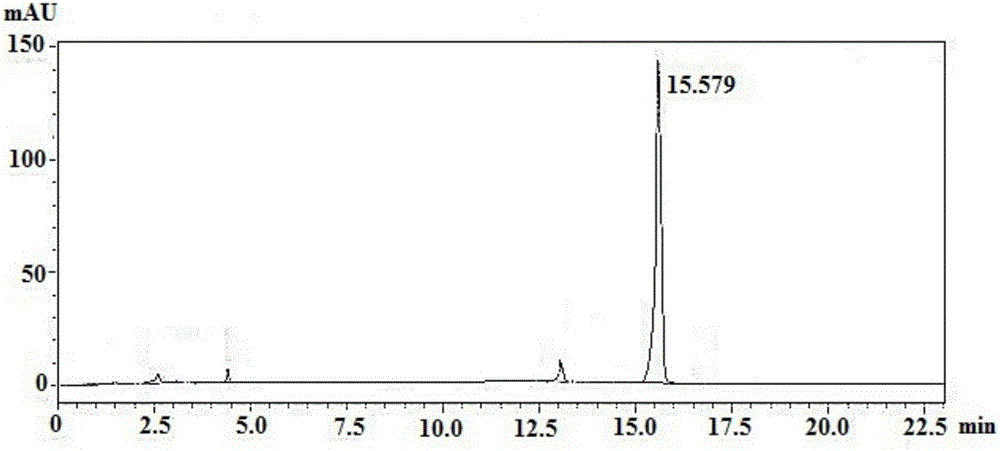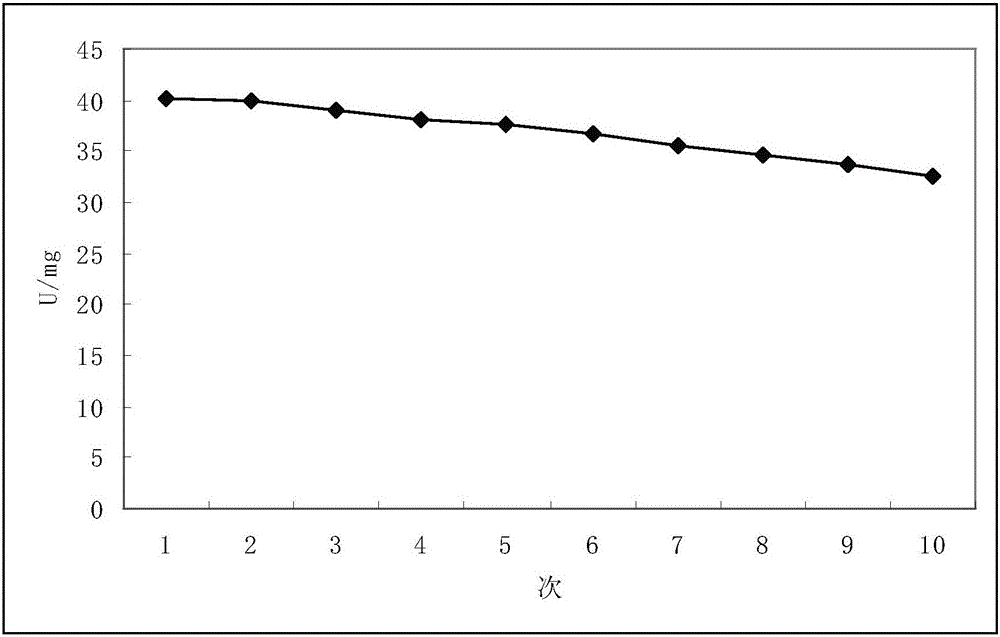Biotransformation method of agmatine sulfate
An agmatine sulfate, biotransformation technology, applied in chemical instruments and methods, organic chemistry, preparation of organic compounds, etc., can solve the problem of no agmatine sulfate biotransformation method, etc., and achieves low cost and reaction conditions. Gentle, simple process effect
- Summary
- Abstract
- Description
- Claims
- Application Information
AI Technical Summary
Problems solved by technology
Method used
Image
Examples
Embodiment 1
[0052] With L-arginine as substrate, arginine decarboxylase as biotransformation catalyst, and pyridoxal phosphate as coenzyme, decarboxylation reaction is carried out to generate crude agmatine, which is treated with dilute sulfuric acid Acidification to obtain the crude product of agmatine sulfate. The mass ratio of arginine decarboxylase to L-arginine is 1:40; the mass ratio of pyridoxal phosphate to L-arginine is 1:1000. The temperature of the reaction system is controlled to be 35°C; the pH of the reaction system is controlled to be 6.5.
[0053] Arginine decarboxylase is arginine decarboxylase after immobilization treatment, and the immobilization treatment of arginine decarboxylase comprises the following steps:
[0054] 1) crushing the engineering bacterial cells containing arginine decarboxylase, centrifuging the engineering bacterial cells, and collecting the arginine decarboxylase liquid;
[0055] 2) Add the arginine decarboxylase solution, additives and immobiliz...
Embodiment 2
[0066] With L-arginine as substrate, arginine decarboxylase as biotransformation catalyst, and pyridoxal phosphate as coenzyme, decarboxylation reaction is carried out to generate crude agmatine, which is treated with dilute sulfuric acid Acidification to obtain the crude product of agmatine sulfate. The mass ratio of arginine decarboxylase to L-arginine is 1:20; the mass ratio of pyridoxal phosphate to L-arginine is 1:800. The temperature of the reaction system is controlled to be 30°C; the pH of the reaction system is controlled to be 6.
[0067] Arginine decarboxylase is arginine decarboxylase after immobilization treatment, and the immobilization treatment of arginine decarboxylase comprises the following steps:
[0068] 1) crushing the engineering bacterial cells containing arginine decarboxylase, centrifuging the engineering bacterial cells, and collecting the arginine decarboxylase liquid;
[0069] 2) Add the arginine decarboxylase solution, additives and immobilized ...
Embodiment 3
[0078] With L-arginine as substrate, arginine decarboxylase as biotransformation catalyst, and pyridoxal phosphate as coenzyme, decarboxylation reaction is carried out to generate crude agmatine, which is treated with dilute sulfuric acid Acidification to obtain the crude product of agmatine sulfate. The mass ratio of arginine decarboxylase to L-arginine is 1:30; the mass ratio of pyridoxal phosphate to L-arginine is 1:500. The temperature of the reaction system is controlled to be 42°C; the pH of the reaction system is controlled to be 7.
[0079] Arginine decarboxylase is arginine decarboxylase after immobilization treatment, and the immobilization treatment of arginine decarboxylase comprises the following steps:
[0080] 1) crushing the engineering bacterial cells containing arginine decarboxylase, centrifuging the engineering bacterial cells, and collecting the arginine decarboxylase liquid;
[0081] 2) Add the arginine decarboxylase solution, additives and immobilized ...
PUM
 Login to View More
Login to View More Abstract
Description
Claims
Application Information
 Login to View More
Login to View More - R&D
- Intellectual Property
- Life Sciences
- Materials
- Tech Scout
- Unparalleled Data Quality
- Higher Quality Content
- 60% Fewer Hallucinations
Browse by: Latest US Patents, China's latest patents, Technical Efficacy Thesaurus, Application Domain, Technology Topic, Popular Technical Reports.
© 2025 PatSnap. All rights reserved.Legal|Privacy policy|Modern Slavery Act Transparency Statement|Sitemap|About US| Contact US: help@patsnap.com


